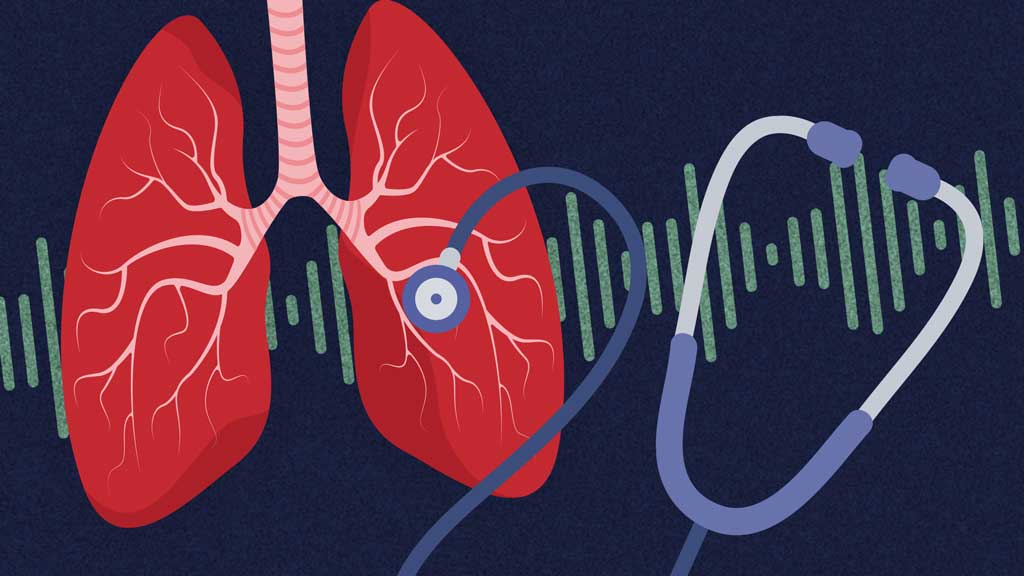From general practice to the intensive care unit, listening to lung sounds can tell you a great deal about a patient and their relative health. However, knowing the difference between rales, a crackle and a wheeze is sometimes still a confusing proposition for many health professionals, especially new graduates.
Part of the reason for this is that some of the language used is interchangeable (for instance, crackles and rales).
Knowing how to correctly identify adventitious breath sounds can tell you, and the other members of the care team, a lot about a patient’s condition.
Rhonchi and Wheezes
Sonorous Wheezes (Rhonchi)
What were once called ‘rhonchi’ are now mostly referred to as sonorous wheezes (though the terms are still used interchangeably). Sonorous wheezes are named thusly because they have a snoring, gurgling quality to them or are similar to a low-pitched moan, more prominent on exhalation.
Sonorous wheezes are caused by blockages to the main airways by mucous secretions, lesions or foreign bodies. Pneumonia, chronic bronchitis and cystic fibrosis are conditions that commonly present with rhonchi.
Coughing can sometimes temporarily clear this breath sound and alter its quality.
Sibilant Wheezes (Wheezes)
Formerly referred to as simply ‘wheezes’, sibilant wheezes are very closely related to the sonorous wheeze. Sibilant wheezes differ from sonorous wheezes as they are a higher-pitched, shrill, continuous whistling sound, occurring when the airway becomes obstructed and narrowed. These are the typical wheezes heard when listening to a patient with asthma.
Sibilant wheezes can be caused by asthma, chronic bronchitis and chronic obstructive pulmonary disease (COPD).
Crackles (Rales)
Crackles are also known as alveolar rales and are the sounds heard in a lung field that has fluid in the small airways. Crackles create fine, short, high-pitched, intermittently crackling sounds.
The cause of crackles can be from air passing through fluid, pus or mucus. They are commonly heard in the bases of the lung lobes during inspiration.
Crackles can be further categorised as coarse or fine:
Fine Crackles
The sound quality of fine crackles is similar to the sound of hair being rubbed between your fingers near your ear and may be heard in congestive heart failure and pulmonary fibrosis.
Coarse Crackles
Coarse crackles are lower-pitched and moist-sounding, like pouring water out of a bottle or ripping open velcro. This lung sound is often a sign of adult respiratory distress syndrome (ARDS), early congestive heart failure, asthma or pulmonary oedema.
Stridor
Stridor is a continuous, high-pitched, crowing sound heard predominantly on inspiration, over the upper airway. Stridor may be a sign of a life-threatening condition and should be treated as an emergency situation.
It usually indicates the partial obstruction of the larger airways, such as the trachea or a main bronchus, and requires immediate attention. It is also the most common type of breath sound heard in children with croup, though it is important to differentiate between croup and a foreign body airway obstruction.
It’s typically loudest over the anterior neck, as air moves turbulently over a partially-obstructed upper airway.
Pleural Friction Rub
A pleural friction rub is caused by the inflammation of the visceral and parietal pleurae. These membranes are usually coated in a protective fluid, but when inflamed, they stick together and make a sound like a harsh grating or creaking. A pleural friction rub often causes a great deal of pain, and the patient will splint their chest and resist breathing deeply to compensate.
A pericardial rub and a pleural rub will often sound similar, and the best way to distinguish between the two is to make the patient hold their breath. If you still hear the rubbing sound, then the patient has a pericardial rub and requires a different treatment.
Potential causes include pleural effusion and pneumothorax. It is best heard in the lower anterior lungs and lateral chest during both inspiration and expiration.
Test Your Knowledge
Question 1 of 3
Which one of the following lung sounds is like a harsh grating or creaking and can be heard in a patient with a pneumothorax?
Topics
References
- Estes, MEZ, Calleja, P, Theobald, K & Harvey, T 2013, Health Assessment and Physical Examination: Australian & New Zealand Edition, Cengage Learning Australia, South Melbourne, Victoria.
 New
New 
